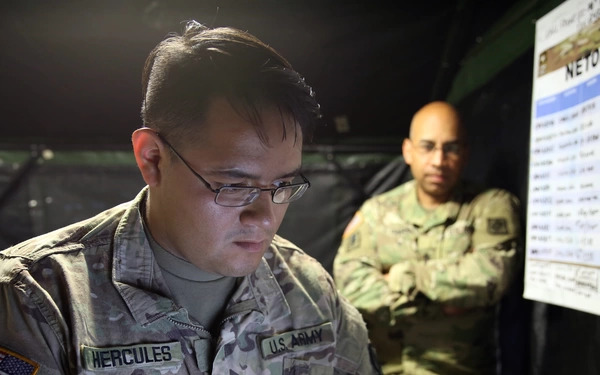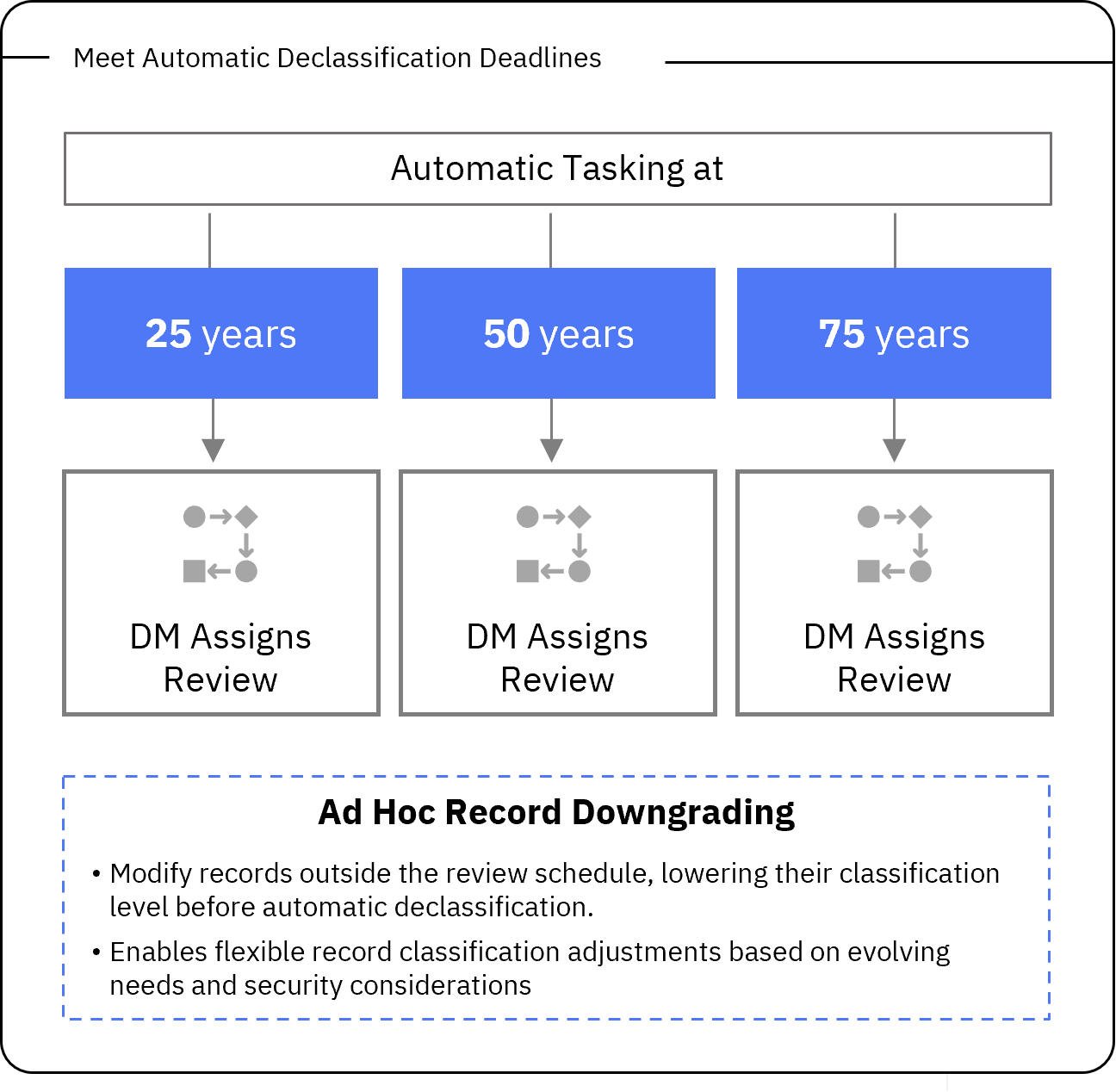Declassification
Feith’s Declassification iQ automates the declassification of sensitive government records, ensuring regulatory compliance. With advanced algorithms and an easy-to-use interface, it promotes smooth interagency collaboration, efficient document processing, and strong security to manage and speed up the declassification process.

Automate Tasks
Automatically designate declassification tasks based on the statutory timeline
Track Milestones
Monitor & Report
Generate reports to show status/progress of all current declassification processes
Collaborate
Refer decision making to partner agencies when record ownership is shared
Support for Automatic & Manual Processes
Declassification iQ modernizes and digitalizes the declassification workflow. Tested by DISA/JITC for Classified RM and DoDM 8180.01 compliant, our system handles records from all sources, such as emails, chats, and documents from file shares or SharePoint, as well as legacy systems.
Declassification iQ speeds up your declassification procedure by integrating with existing software and databases. The system can connect to your email server to automatically ingest emails for declassification and review. The solution can also interface with your SharePoint environment to identify documents that need to be declassified.
Automatic
Executive Order 13526, “Classified National Security Information,” specifies that an automatic declassification review is necessary 25 years after classification, and 75 years if previously exempted. According to the security classification procedures, anything with a classification date prior to 25 years enters into the declassification queue. Declassification iQ lets you meet automatic declassification deadlines by tasking records declassification at 25, 50, and 75 years in accordance with your declassification guidebook, as well as allowing you to redact or downgrade records on an ad hoc basis.
Manual
For one-time declassification projects, action officers create a case where stakeholders can collaborate and assign tasks to specific individuals. These workers then redact information, make notes, and list exemptions in the same way as they would for an automatic declassification task.

Tools for every step of the review process
Declassification review comprises three processes: Automatic Declassification Review (ADR), Mandatory Declassification Review (MDR), and Systematic Declassification Review (SDR), each with unique requirements. Feith has developed specialized modules within Declassification iQ for each, ensuring targeted functionality for the varying scopes of ADR, MDR, and SDR.

Automatic Declassification Review
For ADR, Feith Declassification Manager initiates the review by assessing documents that have reached the declassification threshold based on agency classification guides.
It employs advanced scanning technology, capable of parsing large volumes of records, full text, and metadata, to identify sensitive content. The system flags records that contain potentially sensitive information, which require expert evaluation. Declassification iQ then tasks subject matter experts to review these flagged documents, examining them to determine if they no longer meet the standards for classification. It also incorporates approved declassification guides.
Systematic Declassification Review
SDR, when powered by Declassification iQ, begins with sorting classified documents for review and categorizing them based on their permanent historical value and suitability for declassification.
Following this, documents are aggregated into a centralized interface designed for collaborative review, where multiple stakeholders can analyze content in-depth. This leads to faster decisions regarding full, partial declassification, or exemption. From there, Declassification iQ aids in the processing, redaction, and preparation of the documents for public release.


Mandatory Declassification Review
For MDR, Feith Declassification Manager initially verifies declassification requests for legitimacy.
Upon confirmation, the software rapidly retrieves relevant documents, aiding the agency’s declassification team in assessing if safe declassification is feasible. Declassification iQ then expedites the decision-making, whether for declassification or denial of the request. For partial denials, Declassification iQ includes a redaction tool that enables users to obscure national security information and include reasons without moving the record from the interface.
The solution ensures prompt communication with requesters and, when approved, a systematic release of declassified documents. If denied, requesters can file an administrative appeal through the public facing portal. If this appeal gets denied and escalated to the Information Security Classification Appeals Panel (ISCAP), Declassification iQ will assign that appeal a case number and allow requesters to track its progress.
Refer Declassification to Other Agencies
Declassification iQ serves as a central hub for interagency communication, streamlining the exchange of information and decisions regarding referrals. Our system facilitates real-time updates and transparent communication channels, ensuring all parties are aligned and informed. By integrating seamlessly with the National Declassification Center’s protocols, Declassification iQ ensures that your agency’s referrals are managed in accordance with the highest standards of efficiency and compliance.

NARA Accession
To ensure the integrity of the classification system, NARA requires a transfer package for all accessioned or declassified records. The package must include a certification that the records have been reviewed and declassified in accordance with current executive order and procedures.
Declassification iQ’s system generates a PDF or TIFF of the declassified document, with an XML metadata file, which can be exported and transferred to NARA.
It then automatically assembles a package including the certification letter, XML metadata file, PDFa or TIFF of the declassified document, and any associated exemption information. This package is now available for release by the Records Manager.
The classification system is a complex and ever-evolving process, but it is an essential part of our national security. Declassification iQ makes the declassification process more efficient and less error-prone, while providing an auditable trail of every decision made.
Key Benefits of Declassification iQ
01
02
Audit Trail Accountability: All system activities, including changes and updates in a document’s status or modify notifications, create audit table entries. Ensure your declassification process is defensible and accountable.
03
Declassification Tracking Process: Provides a timeline of each record’s status through the declassification process, as well as reports on the progress of the declassification program.
04
Automated Exemption Indexing: Reason codes are used to identify exempt information and construct an exemption index. The exemption index is built automatically by consulting reason codes for each exemption.
05
Declassification Quality Control: Ensure the safety of your material by implementing quality control measures throughout the declassification process.
06
Exemption Detection Automation: Automatically show terms that would exempt a record from Automatic Declassification based on declassification guide.
08
Digital Redaction Tools: Automatically detect and erase specific text or images, including banner markings, in declassified documents directly within Declassification iQ’s interface.
